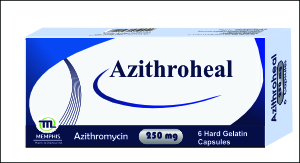TRADE NAME: AZITHROHEAL 250 mg HARD GELATIN CAPSULES. GENERIC NAME: Azithromycin. COMPOSITION: Each capsule contains: Active ingredient: Azithromycin Dihydrate 262.02 mg (Equivalent to Azithromycin 250 mg) Excipients: Anhydrous lactose, Corn starch, Sodium lauryl sulphate, Magnesium stearate. Composition of capsule shell (size 1): Cap: Gelatin, Titanium dioxide, Brilliant blue, Erythrosine, Carmoisine, Quinoline. Body: Gelatin, Titnium dioxide, Sunset yellow, Carmoisine. PHARMACEUTICAL FORM: Hard gelatin capsules. PHARMACOLOGICAL ACTION: PHARMACODYNAMICS: Azithromycin is a macrolide antibiotic belonging to the azalide group. The molecule is constructed by adding a nitrogen atom to the lactone ring of erythromycin A. The mechanism of action of azithromycin is based upon the suppression of bacterial protein synthesis by binding to the ribosomal 50S sub-unit and inhibition of peptide translocation. PHARMACOKINETICS: Absorption Bioavailability after oral administration is approximately 37%. Peak concentrations in the plasma are attained 2-3 hours after taking the medicinal product. Distribution Orally administered azithromycin is widely distributed throughout the body. In pharmacokinetic studies it has been demonstrated that the concentrations of azithromycin measured in tissues are noticeably higher (as much as 50 times) than those measured in plasma, which indicates that the agent strongly binds to tissues. Binding to serum proteins varies according to concentration and ranges from 12% at 0.5 microgram/ml up to 52% at 0.05 microgram/ml. The mean volume of distribution at steady state (VVss) has been calculated to be 31.1 l/kg. Elimination Terminal plasma elimination half-life closely reflects the elimination half-life from tissues of 2-4 days. Approximately 12% of an intravenously administered dose of azithromycin is excreted unchanged in urine within the following three days. Particularly high concentrations of unchanged azithromycin have been found in human bile. In the same source, 10 metabolites were also detected, which were formed through N- and O-demethylation, hydroxylation of desosamine- and aglycone rings and degradation of cladinose conjugate. Comparison of the results of liquid chromatography and microbiological analyses has shown that the metabolites of azithromycin are not microbiologically active. In animal tests, high concentrations of azithromycin have been found in phagocytes. It has also been established that during active phagocytosis higher concentrations of azithromycin are released than are released from inactive phagocytes. Consequently, in animal tests the azithromycin concentrations measured in inflammation foci were high. INDICATIONS: AZITHROHEAL is indicated for the treatment of the following infections when known or likely to be due to one or more susceptible microorganisms: - bronchitis - community-acquired pneumonia - sinusitis - pharyngitis/tonsillitis (see warnings and precautions regarding streptococcal infections) - otitis media - skin and soft tissue infections - uncomplicated genital infections due to Chlamydia trachomatis Consideration should be given to official guidance regarding the appropriate use of antibacterial agents. DOSAGE AND ADMINISTRATION: Posology Children over 45 kg body weight and adults, including elderly patients The total dosage of AZITHROHEAL is 1500 mg which should be given over three days (500 mg once daily). In uncomplicated genital infections due to Chlamydia trachomatis, the dosage is 1000 mg as a single oral dose. AZITHROHEAL 250 mg capsules are suitable only for children of at least 45 kg body weight for whom the adult dose may be used. Renal insufficiency In patients whose renal function is slightly impaired (creatinine clearance >40 ml/min), dose adjustment is not necessary. No studies have been conducted in patients with a creatinine clearance of <40 ml/min and consequently caution must be exercised in the use of AZITHROHEAL for these patients. Hepatic insufficiency Since azithromycin is metabolised in the liver and excreted in the bile, the drug should not be given to patients suffering from severe liver diseases. No studies have been conducted regarding treatment of such patients with azithromycin. Method of Administration: AZITHROHEAL 250 mg capsules should be administered as a single daily dose and should be taken at least 1 hour before or 2 hours after food. CONTRAINDICATIONS: • Hypersensitivity to the active substance or to any of the listed excipients or erythromycin, any macrolide or ketolide antibiotic. • AZITHROHEAL capsule is contraindicated in patients with a history of cholestatic jaundice/hepatic dysfunction associated with prior use of AZITHROHEAL capsule.
